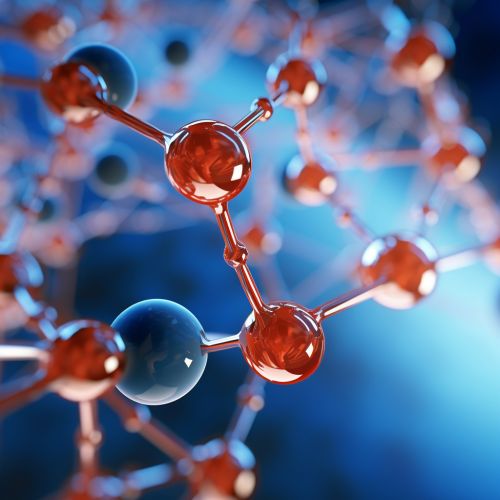Retinal (molecule)
Overview
Retinal, also known as retinaldehyde, is a polyene chromophore, which is a molecule that absorbs certain wavelengths of visible light, and is involved in the visual phototransduction pathway. It is one of the many forms of vitamin A, which are essential nutrients that play a key role in vision, growth, reproduction, and the immune system.
Structure and Properties
Retinal is a molecule composed of a long hydrocarbon chain with a cyclic ring structure at one end and an aldehyde group at the other. The molecule is planar, and its structure allows it to absorb light in the visible spectrum. The long hydrocarbon chain consists of a series of conjugated double bonds, which are responsible for the molecule's ability to absorb light. The cyclic ring structure, known as a beta-ionone ring, is a common feature of many vitamin A compounds.


The aldehyde group of retinal is reactive, allowing the molecule to form a Schiff base linkage with the protein opsin to form rhodopsin, the light-sensitive pigment found in the rods of the retina. This reaction is reversible, and the retinal molecule can be released from the opsin protein when it absorbs a photon of light.
Role in Vision
The primary role of retinal in the body is in the process of vision. It is a key component of the visual phototransduction pathway, which is the process by which light is converted into electrical signals in the rod cells, cone cells, and photosensitive ganglion cells of the retina.
When a photon of light strikes the retinal molecule, it causes a change in the shape of the molecule, a process known as isomerization. This change in shape triggers a series of chemical reactions that ultimately result in an electrical signal being sent to the brain.
Retinal is unique among the forms of vitamin A in that it is the only form that can be used directly by the visual system. Other forms of vitamin A must be converted into retinal before they can be used in the visual process.
Metabolism and Biochemistry
Retinal is derived from the dietary intake of vitamin A compounds, which are found in a variety of foods, including liver, fish, and some fruits and vegetables. These compounds are converted into retinal in the intestines and liver.
Once formed, retinal can be stored in the liver or transported to the retina, where it is used in the visual process. In the retina, retinal is combined with the protein opsin to form the light-sensitive pigment rhodopsin.
Retinal can also be converted into other forms of vitamin A, such as retinol and retinoic acid, which have other functions in the body. For example, retinol is important for growth and development, while retinoic acid plays a key role in cell differentiation and embryonic development.
Health and Disease
Deficiencies in vitamin A, and therefore retinal, can lead to a number of health problems. One of the most well-known of these is night blindness, a condition in which the eyes have difficulty adapting to low light conditions. This is because retinal is a key component of the light-sensitive pigment rhodopsin, which is found in the rods of the retina, the cells responsible for vision in low light conditions.
In addition to night blindness, vitamin A deficiency can also lead to dry eyes, skin problems, and an increased susceptibility to infections. On the other hand, an excess of vitamin A can also be harmful, leading to a condition known as hypervitaminosis A, which can cause a range of symptoms including dizziness, nausea, hair loss, and even death in severe cases.
There are also a number of genetic diseases that affect the metabolism of retinal and other forms of vitamin A. These include various forms of retinitis pigmentosa, a group of inherited eye diseases that cause progressive vision loss.
